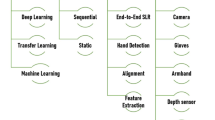Abstract
The non-intrusion and device-free sign language recognition (SLR) is of great significance to improve the quality of life, broaden living space and enhance social service for the deaf and mute. In this paper, we propose a SLR system framework, called WiCLR, for identifying isolated words in Chinese sign language exploring the channel state information (CSI). WiCLR is made up entirely of commercial wireless devices, which does not incur significant deployment and maintenance overhead. In the framework we devise a signal denoising method to remove the environment noise and the internal state transitions in commercial devices. Moreover, we propose the multi-stream anomaly detection algorithm in action segmentation and fusion. Finally, the extreme learning machine (ELM) is utilized to meet the accuracy and real-time requirements. The experiment results show that the recognition accuracy of the approach reaches 94.3% and 91.7% respectively in an empty conference room and a laboratory.
Access this chapter
Tax calculation will be finalised at checkout
Purchases are for personal use only
Similar content being viewed by others
References
National Bureau of Statistics: The second leading group for the national sampling survey of disabled people. The second national disabled people sampling survey main data bulletin
Gao, W., Fang, G., Zhao, D.: A Chinese sign language recognition system based on SOFM/SRN/HMM. Pattern Recogn. 37(12), 2389–2402 (2004)
Li, K., Zhou, Z., Lee, C.H.: Sign transition modeling and a scalable solution to continuous sign language recognition for real-world applications. ACM Trans. Access. Comput. 8(2), 1–23 (2016)
Li, Y.: Research of Chinese sign language recognition and exploration of rehabilitation application based on surface Electromyogram. University of Science and Technology of China (2013)
Yang, X.: Research of Chinese sign language recognition technology based on fusion of surface electromyography and inertial sensor. University of Science and Technology of China (2016)
Zhao, T., Liu, J., Wang, Y., Liu, H., Chen, Y.: PPG-based finger-level gesture recognition leveraging wearables. In: IEEE International Conference on Computer Communications. IEEE (2018)
Sun, C., Zhang, T., Bao, B.K., et al.: Discriminative exemplar coding for sign language recognition with kinect. IEEE Trans. Cybern. 43(5), 1418–1428 (2013)
Chai, X., Li, G., Lin, Y., Xu, Z., Tang, Y., Chen, X.: Sign language recognition and translation with kinect. In: The 10th IEEE International Conference on Automatic Face and Gesture Recognition, pp. 22–26. IEEE (2013)
Marin, G., Dominio, F., Zanuttigh, P.: Hand gesture recognition with leap motion and kinect devices. In: IEEE International Conference on Image Processing, pp. 1565–1569. IEEE (2014)
Wu, K., Xiao, J., Yi, Y., et al.: FILA: fine-grained indoor localization. Proc. IEEE INFOCOM 131(5), 2210–2218 (2012)
Xiao, J., Wu, K., Yi, Y., et al.: FIFS: fine-grained indoor fingerprinting system. In: International Conference on Computer Communications and Networks, pp. 1–7. IEEE (2012)
Xiao, J., Wu, K., Yi, Y., et al.: Pilot: passive device-free indoor localization using channel state information, pp. 236–245 (2013)
Chapre, Y., Ignjatovic, A., Seneviratne, A., et al.: CSI-MIMO: an efficient Wi-Fi fingerprinting using channel state information with MIMO. Pervasive Mob. Comput. 23, 89–103 (2015)
Wu, C.: Wireless indoor positioning via crowd sensing. Tsinghua University (2015)
Kosba, A.E., Saeed, A., Youssef, M.: RASID: a robust WLAN device-free passive motion detection system. In: 2012 IEEE International Conference on Pervasive Computing and Communications (PerCom), pp. 180–189. IEEE (2012)
Xiao, J., Wu, K., Yi, Y., et al.: FIMD: fine-grained device-free motion detection. In: 2012 IEEE 18th International Conference on Parallel and Distributed Systems (ICPADS), pp. 229–235. IEEE (2012)
Qian, K., Wu, C., Yang, Z., et al.: PADS: passive detection of moving targets with dynamic speed using PHY layer information. In: IEEE International Conference on Parallel and Distributed Systems, pp. 1–8. IEEE (2015)
Liu, W., Liu, Z., Wang, L., et al.: Human movement detection and gait periodicity analysis via channel state information. Int. J. Comput. Syst. Sci. Eng. (2017)
Wang, Y., Liu, J., Chen, Y., et al.: E-eyes: device-free location-oriented activity identification using fine-grained WiFi signatures. In: International Conference on Mobile Computing and Networking, pp. 617–628. ACM (2014)
Wang, G., Zou, Y., Zhou, Z., et al.: We can hear you with Wi-Fi! In: ACM International Conference on Mobile Computing and Networking, pp. 593–604. ACM (2014)
Han, C., Wu, K., Wang, Y.: WiFall: device-free fall detection by wireless networks. In: 2014 Proceedings IEEE INFOCOM, pp. 271–279. IEEE (2014)
Zheng, X., Wang, J., Shangguan, L., et al.: Smokey: ubiquitous smoking detection with commercial WiFi infrastructures. In: IEEE INFOCOM 2016 - IEEE Conference on Computer Communications, pp. 1–9. IEEE (2016)
Li, H., Yang, W., Wang, J., et al.: WiFinger: talk to your smart devices with finger-grained gesture. In: ACM International Joint Conference on Pervasive and Ubiquitous Computing, pp. 250–261. ACM (2016)
Wang, W., Liu, A.X., Shahzad, M., et al.: Device-free human activity recognition using commercial WiFi devices. IEEE J. Sel. Areas Commun. 35, 1118–1131 (2017)
Xie, Y., Li, Z., Li, M.: Precise power delay profiling with commodity WiFi. In: International Conference on Mobile Computing and Networking, pp. 53–64. ACM (2015)
Wang, H., Zhang, D., Ma, J., et al.: Human respiration detection with commodity WiFi devices: do user location and body orientation matter? In: ACM International Joint Conference on Pervasive and Ubiquitous Computing, pp. 25–36. ACM (2016)
Author information
Authors and Affiliations
Corresponding author
Editor information
Editors and Affiliations
Rights and permissions
Copyright information
© 2019 ICST Institute for Computer Sciences, Social Informatics and Telecommunications Engineering
About this paper
Cite this paper
Lin, W., Yu, L., Nan, J. (2019). WiCLR: A Sign Language Recognition System Framework Based on Wireless Sensing. In: Li, Q., Song, S., Li, R., Xu, Y., Xi, W., Gao, H. (eds) Broadband Communications, Networks, and Systems. Broadnets 2019. Lecture Notes of the Institute for Computer Sciences, Social Informatics and Telecommunications Engineering, vol 303. Springer, Cham. https://doi.org/10.1007/978-3-030-36442-7_7
Download citation
DOI: https://doi.org/10.1007/978-3-030-36442-7_7
Published:
Publisher Name: Springer, Cham
Print ISBN: 978-3-030-36441-0
Online ISBN: 978-3-030-36442-7
eBook Packages: Computer ScienceComputer Science (R0)




